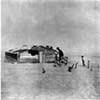|
TEXAS HISTORY:
The Depression
TEKS:
OBJECTIVE:
Identify
the problems of the Dust Bowl years through photos and discussion.
MATERIALS:
- Texas, Our Texas-
7th grade Texas History textbook photographs
page 529: Dust Rolling
Through Amarillo, 1936
page 527: Cotton Pickers near Robstown
page 527: Annual Move - Otis Dozier
- Texas Almanac
- See images below
|
|
FOCUS:
Show students various
photographs and paintings of the Dust Bowl and encourage comments and
questions to begin discussion of the Dust Bowl era.
DISCUSSION:
- What do these
photos have in common? (wind, dust, all of the photos are black and
white)
- What factors
do you think helped create the Dust Bowl? (plowing grassland, lack
of soil conservation, drought condition)
FOCUS ACTIVITY:
Write a journal
entry describing what it would be like if you stepped into one of these
photographs. Use all five senses. What do you see, hear, feel,
taste, smell?
RESEARCH ACTIVITY:
Use the Texas
Almanac, Internet, periodicals, and magazines. The drought of the
1930's was not the only bad drought Texas has experienced. Using the
Texas Almanac, have the students research the following questions:
- Besides the
1930's, when else has Texas experienced severe drought conditions?
- How much rain
did the Panhandle receive during the Dust Bowl?
- How does that
compare to the recent drought of 1998 or the droughts of the 1950's
or any other time of serious drought?
- How did the Dust
Bowl affect the economy of the Panhandle in the 1930's (For
example, how many farms per county were there in the Texas Panhandle
in 1929? How many were there in 1939?)
- What was the
average farm income in Texas in 1929 as opposed to 1939?
- What percentage
of Texas farmers sold or lost their farms in the 1930's?
- How would farm
loss effect the economy of Amarillo?
- What happened
to families who lost their farms?
- How did government
action effect the Dust Bowl?
EXTENSION ACTIVITY:
- Have students
record oral histories of people who survived the Dust Bowl. This can
be done individually, in small groups, or as an extra credit project.
Relatives, local nursing homes, senior citizen organizations, and
churches are all good sources of people to interview.
- Have local agriculture
experts visit the classroom and discuss droughts of recent memory
and why they did not have the same impact as the Dust Bowl. Discuss
ways students can help prevent another Dust Bowl from occurring (water
and soil conservation.)
CULMINATING PROJECT:
Students will create a multimedia presentation using Power Point or
Hyperstudio detailing the effects of the Dust Bowl on the Texas Panhandle.
Information should
be visual, written, and auditory. Reports should include information
from a variety of sources, including first hand accounts. A bibliography
or source page must be included.
RESOURCES:
Agriculture Master
Speakers, scientist from the Bushland USDA research station, local county
extensions agents, etc.
|


